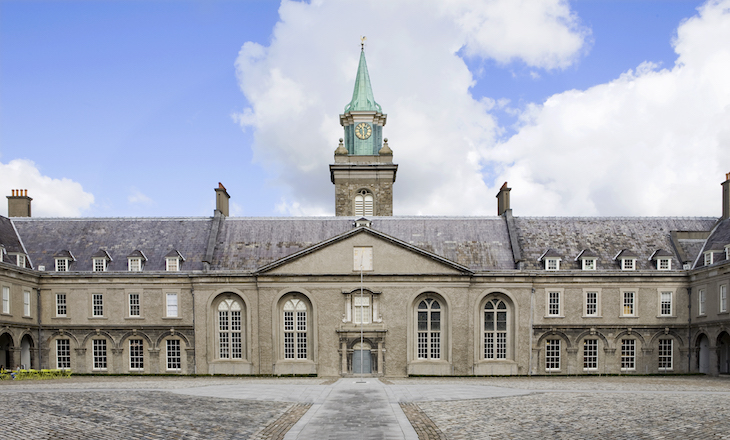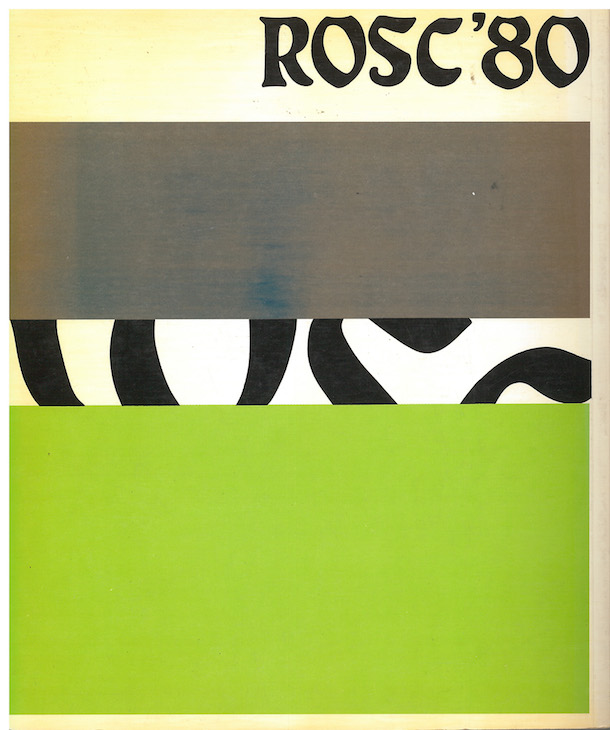Standing in the walled garden of the Royal Hospital in Kilmainham, Dublin, with its stone urns and hedge-lined radial avenues, it is just possible to ignore the tower cranes looming overhead and imagine oneself in a quiet courtly haven, rather than a febrile city undergoing more questionable redevelopment.
Overlooking this Renaissance-style garden is a commanding 17th-century building, originally a military hospital modelled on Les Invalides in Paris. This faintly incongruous site has been home to the Irish Museum of Modern Art (IMMA) since its establishment in 1991. Three years previously it was one of the venues for the last of the ROSC art exhibitions – its name an Irish word roughly translated as ‘the poetry of vision’– which ran from 1967–88. More than a simple coincidence of venue, these two events – the discontinuation of ROSC and the establishment of IMMA – were intimately connected.

Irish Museum of Modern Art, Dublin
This year, IMMA marks the half-century since the first of these seminal exhibitions. ROSC ’67 was, by all accounts, a seismic event. Founded by one of Ireland’s foremost modern architects, Michael Scott, the show, featuring work by Picasso, Miro, de Kooning, and Bacon, has been described as Ireland’s Armory Show, though it could equally represent Ireland’s answer to the 1910 Post-Impressionist exhibition in London: a show of modern art for a more or less unfamiliar public. (Funnily enough, Dublin was, in 1908, home to the world’s first public gallery of modern art, the product of a short-lived progressive approach to the visual arts.) Critical focus upon ROSC has tended to emphasise the ‘controversies’ and ‘outrages’ it provoked, sometimes at the expense of its genuine successes. Controversies there were, particularly as later instalments expanded to include contemporary work, work by Irish artists (a source of particular dispute), and, from 1980, performance and installation art.
Official public statements about ROSC reflect this changing set of priorities. In the first show, modern work (mostly painting) was exhibited alongside works of Celtic art (high crosses, stone pillars, gold artefacts), a formalist gesture intended to justify the abstractions of modernism by reference to those of antiquity, which brought with it a whiff of the primitivism of high modernism itself: think Picasso’s enthusiasm for ‘primal’ African sculpture. The catalogue for ROSC ’71 placed it within the wider culture of contemporary periodical exhibitions, specifically Documenta. It was also saddled with an educational remit, and frequently cast as a substitute for a permanent institution dedicated to modern and contemporary art; in her introduction to the 1980 catalogue, artist Dorothy Walker called ROSC ‘a quadrennial Museum of Modern Art for the Irish public’.

Front cover of the catalogue to accompany the ROSC ’80 exhibition
As such, IMMA represents a key piece of visual art infrastructure for which ROSC was a long-running and provisional substitute. In dedicating a portion of this year’s programme to ROSC, IMMA is exploring its own origins as well as, arguably, repaying a debt. So far, one inaugural discussion-based event has taken place, and an exhibition – based on the holdings of the National Irish Visual Arts Library relating to ROSC – runs until 18 June. Further events, including a symposium on ROSC’s legacy, are to follow.
There has been much focus on the past in Ireland recently, in light of last year’s centenary of the 1916 Rising. IMMA’s ‘Ireland 2016’ programme was exemplary in this respect. Elsewhere, however, institutions are looking to the future. In the last few months, several new appointments have been made which promise to contribute to the experimental contemporary art scene in the city. Lívia Páldi joins the innovative Projects Arts Centre as curator of visual arts, while Irish curator Georgina Jackson has been appointed director of the Douglas Hyde Gallery, Trinity College Dublin, replacing John Hutchinson, whose singular vision has been a steering force in the Irish art world for the past 25 years.
In a recent solo exhibition at the Douglas Hyde, artist Sean Lynch included – alongside a set of photographs of the hammy ‘heritage displays’ at the Burren Centre in Kilfenora, Co. Clare – the original 12th-century Tau Cross of Kilnaboy, itself previously exhibited at ROSC ’67. Standing in the Douglas Hyde, surrounded by the blatant kitsch of Lynch’s photographs, I was unsure if the cross was real or not. This is typical of Lynch’s skewed anthropological approach, making strangely comic matter out of what seems otherwise unremarkable. In contrast to its treatment within ROSC, the Tau Cross here looked parodic, jarring. By refusing to make it mythic, Lynch gave it a theatrical, living quality – providing, in the process, an object lesson in how we might handle the relics of a charged cultural heritage.
From the June 2017 issue of Apollo: preview and subscribe here.

‘The first ROSC exhibition was, by all accounts, a seismic event’
Front cover (detail) of the catalogue to accompany the ROSC ’71 exhibition in Dublin
Share
Standing in the walled garden of the Royal Hospital in Kilmainham, Dublin, with its stone urns and hedge-lined radial avenues, it is just possible to ignore the tower cranes looming overhead and imagine oneself in a quiet courtly haven, rather than a febrile city undergoing more questionable redevelopment.
Overlooking this Renaissance-style garden is a commanding 17th-century building, originally a military hospital modelled on Les Invalides in Paris. This faintly incongruous site has been home to the Irish Museum of Modern Art (IMMA) since its establishment in 1991. Three years previously it was one of the venues for the last of the ROSC art exhibitions – its name an Irish word roughly translated as ‘the poetry of vision’– which ran from 1967–88. More than a simple coincidence of venue, these two events – the discontinuation of ROSC and the establishment of IMMA – were intimately connected.
Irish Museum of Modern Art, Dublin
This year, IMMA marks the half-century since the first of these seminal exhibitions. ROSC ’67 was, by all accounts, a seismic event. Founded by one of Ireland’s foremost modern architects, Michael Scott, the show, featuring work by Picasso, Miro, de Kooning, and Bacon, has been described as Ireland’s Armory Show, though it could equally represent Ireland’s answer to the 1910 Post-Impressionist exhibition in London: a show of modern art for a more or less unfamiliar public. (Funnily enough, Dublin was, in 1908, home to the world’s first public gallery of modern art, the product of a short-lived progressive approach to the visual arts.) Critical focus upon ROSC has tended to emphasise the ‘controversies’ and ‘outrages’ it provoked, sometimes at the expense of its genuine successes. Controversies there were, particularly as later instalments expanded to include contemporary work, work by Irish artists (a source of particular dispute), and, from 1980, performance and installation art.
Official public statements about ROSC reflect this changing set of priorities. In the first show, modern work (mostly painting) was exhibited alongside works of Celtic art (high crosses, stone pillars, gold artefacts), a formalist gesture intended to justify the abstractions of modernism by reference to those of antiquity, which brought with it a whiff of the primitivism of high modernism itself: think Picasso’s enthusiasm for ‘primal’ African sculpture. The catalogue for ROSC ’71 placed it within the wider culture of contemporary periodical exhibitions, specifically Documenta. It was also saddled with an educational remit, and frequently cast as a substitute for a permanent institution dedicated to modern and contemporary art; in her introduction to the 1980 catalogue, artist Dorothy Walker called ROSC ‘a quadrennial Museum of Modern Art for the Irish public’.
Front cover of the catalogue to accompany the ROSC ’80 exhibition
As such, IMMA represents a key piece of visual art infrastructure for which ROSC was a long-running and provisional substitute. In dedicating a portion of this year’s programme to ROSC, IMMA is exploring its own origins as well as, arguably, repaying a debt. So far, one inaugural discussion-based event has taken place, and an exhibition – based on the holdings of the National Irish Visual Arts Library relating to ROSC – runs until 18 June. Further events, including a symposium on ROSC’s legacy, are to follow.
There has been much focus on the past in Ireland recently, in light of last year’s centenary of the 1916 Rising. IMMA’s ‘Ireland 2016’ programme was exemplary in this respect. Elsewhere, however, institutions are looking to the future. In the last few months, several new appointments have been made which promise to contribute to the experimental contemporary art scene in the city. Lívia Páldi joins the innovative Projects Arts Centre as curator of visual arts, while Irish curator Georgina Jackson has been appointed director of the Douglas Hyde Gallery, Trinity College Dublin, replacing John Hutchinson, whose singular vision has been a steering force in the Irish art world for the past 25 years.
In a recent solo exhibition at the Douglas Hyde, artist Sean Lynch included – alongside a set of photographs of the hammy ‘heritage displays’ at the Burren Centre in Kilfenora, Co. Clare – the original 12th-century Tau Cross of Kilnaboy, itself previously exhibited at ROSC ’67. Standing in the Douglas Hyde, surrounded by the blatant kitsch of Lynch’s photographs, I was unsure if the cross was real or not. This is typical of Lynch’s skewed anthropological approach, making strangely comic matter out of what seems otherwise unremarkable. In contrast to its treatment within ROSC, the Tau Cross here looked parodic, jarring. By refusing to make it mythic, Lynch gave it a theatrical, living quality – providing, in the process, an object lesson in how we might handle the relics of a charged cultural heritage.
From the June 2017 issue of Apollo: preview and subscribe here.
Unlimited access from just $16 every 3 months
Subscribe to get unlimited and exclusive access to the top art stories, interviews and exhibition reviews.
Share
Recommended for you
Making space for Dublin’s artists
There is a crisis of artists’ studio space in the city – but the artists are organising against it
The real threat to Northern Ireland’s museums
Funding cuts are a danger, but it’s the more insidious changes to the structure and attitude of public sector that we should really worry about
The National Gallery of Ireland is finally to reopen
It’s been a long wait indeed, but the gallery’s refurbishment is nearing completion, and there’s a good line-up of temporary exhibitions, too